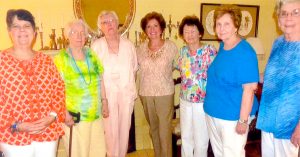
The Ann Fulmore Harllee Chapter of the UDC met May 12, 2016 at the home of Mrs. Phyllis Hagan in Bennettsville. Upon arrival Mrs. Mattie Strickland led the group in prayer after which everyone enjoyed delicious refreshments consisting of chicken salad, fresh fruit and assorted pickles.
Mrs. Strickland called the meeting to order and everyone participated in the club ritual which was closed with prayer by Mrs. Hagan. The minutes were read by Mary Mac Stephens and Fay Sloan gave the treasurer’s report. Everyone was reminded that our chapter will host the district meeting in Dillon in February of 2017. The new state officers will begin their new term in November of 2016 and Chris Harris will be the chaplain for the Pee Dee district. Christ Harris reported that she attended the scholarship reception held at Francis Marion University.
The program for the afternoon was given by Mrs. Marty Rankin who presented some interesting facts about the diseases and ailments that plagued the soldiers during the time of the War Between the States. Before she began her program, she told of an unusual incident that happened concerning a doll of the Confederacy. This doll, known as the Silent Witness doll, was in the parlor of the McLean House where General Robert E. Lee surrendered to General Ulysses Grant in 1865. The doll had belonged to Wilmer and Virginia McLean’s daughter Luna. The doll had been left on the sofa in the room where Lee and Grant met.
Following the surrender, the Union soldiers started to plunder the McLean parlor taking many souvenirs with them, including the doll. The doll was taken home by Capt. Thomas Moore and stayed in his family as a “war trophy” for a century. The doll was donated to the National Park Service in 1992 and is now on permanent display at the Visitors Center at the Appomattox Court House National Historical Park.
Mrs. Rankin then related some of the problems that faced the troops during the time of the war. The mortality rate of the soldiers due to disease was double that of soldiers who were wounded in battles. Many diseases were caused by insects and uncleanliness. Camps were set up with the tents in close proximity which enabled the diseases to spread more rapidly.
There was a basic lack of knowledge of medical treatments as well as a lack of medical supplies which only compounded the problem. Among highly contagious diseases were measles, smallpox, mumps, typhoid as well as many others. It has been said that measles was the worst disease affecting the camp.
Among many other things there was a lack of water, tainted water, mishandled or poorly prepared foods, heat, cold, and unburied animal carcasses. Hospitals were few and understaffed because of a shortage of trained doctors and nurses.
Diseases in one form or another may have affected the men’s nervous systems, digestive systems, skin, bones, or a combination of one or more parts of a soldier’s body. There were many contributing factors which may have led to a soldier’s illness and possible death. Because of modern-day medicine and better trained doctors, many of these diseases have been eradicated. Soldiers of the twenty-first century still battle diseases today, but many suffer horrible wounds caused by newly developed weapons which leave them disabled and emotionally debilitated. As through the ages many men and women have given much so we can enjoy freedom. A freedom which we can all experience and should never take for granted. At the conclusion of the program, Mrs. Strickland lit a candle in memory of our deceased member Jimmie Rogers who died September 16, 2015 at age 102. A second candle was lit in memory of all other deceased members in the Pee Dee district.
After this observance, the meeting was adjourned.










